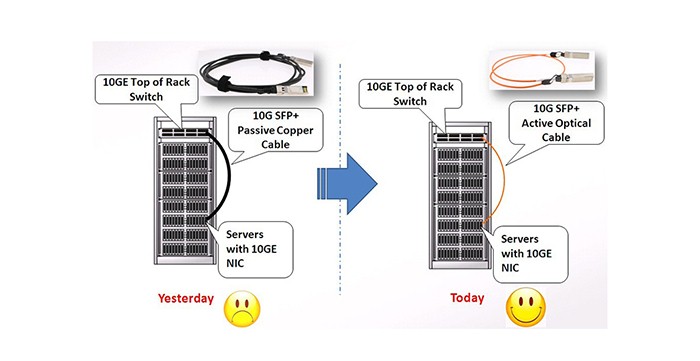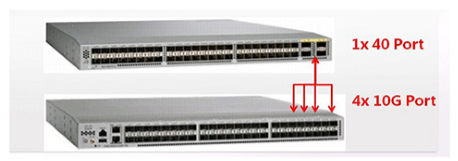The rapid application of the Internet and smart terminals has caused the explosive growth of global data volume, which has greatly promoted the development of high-performance supercomputing centers (HPC) and data center markets with high-speed routers, supercomputing and storage as the core.
Active optical cable products are one of the main interconnection methods between these core devices. The active optical cable market research report from CIR shows that its market size reached US$720 million in 2012 and is expected to reach 2017. The figure has doubled to US$1.9 billion, and the prospects are promising.
With servers, switches and other devices providing 40G/100G ports, data With the gradual commercialization of the center, there is an increasing demand for high-speed optical interconnection products. Currently, domestic device manufacturers continue to develop and innovate optical interconnection technology, and have an in-depth understanding and understanding of high-speed integrated parallel optical modules and high-frequency signal integrity technology. Research.
The key requirements for optical interconnect products are high speed, high density, low cost and low power consumption.
The current mainstream high-speed optical interconnect products in the market include 10Gbps SFP+ AOC, 40Gbps QSFP+AOC, 56GQSFP+AOC and 120Gbps CXP AOC, etc.
The following figure shows the optical interconnect AOC market reported by CIRexpected.

Significant advantages and applications of high-speed optical interconnect technology
Data center/cloud computing system is updated The demand for high bandwidth and lower power consumption is becoming more and more urgent, and AOC active optical cable is one of the best solutions to meet this demand.
AOC active optical cable has many advantages compared with interconnection copper cables. Significant advantages, such as lower transmission power on the system link, only one-fourth the weight of a direct-connect copper cable, slightly half the volume of a copper cable, and better air flow and heat dissipation in the computer room cabling system, The bending radius of optical cables is smaller than that of copper cables, the transmission distance is longer (can reach 100~300 meters), and the bit error rate of the product transmission performance is also better, BER can reach 10^-15.
Compared with optical transceiver modules, AOC active optical cables have non-exposed optical interfaces, so there is no problem of optical interface cleaning and contamination. System stability and reliability are greatly improved, and machine room maintenance costs are reduced.
p>High-speed optical interconnect products 40Gbps QSFP+ AOC and 120Gbps CXP AOC are no longer available Adopt TOSA/ROSA in traditional pluggable transceiversStructural design, using highly integrated array light engine core device technology.
The picture below is 40G QSFP+

Adopt COB (Chip on Board) integration technology on PCBA to achieve integrated mode - packaging Small, high speed, low power consumption (QSFP+ power consumption is less than 1.5W, CXP power consumption is less than 2.5W)
At the transmitter end, the array optical engine processes multiple high-speed electrical channels at the same time. Convert into multiple optical signals, combine these optical signals, and transmit the information to the next node in the cloud computing system or data center room through a 12-core (24-core) MPO high-density optical cable.
< p>At the receiving end, the array optical engine converts the optical signals in the MPO optical cable back to electrical signals, and transmits multiple electrical signals to the device for processing. These products are fully suitable for infiniband interconnection application scenarios and comply with Ethernet IEEE 802.3ba. In the field of data centers and cloud computing systems, array optical engine technology has been widely used in active optical cable products - interconnections between servers and switches.
However, optical engine technology also faces great challenges. The core laser is monopolized by a few large international manufacturers. The price is high, and the welding technology between the laser driver and the limiting amplification chip also affects the manufacturing efficiency, restricting the large-scale promotion of domestic manufacturers.
For these reasons, integrated silicon photonics technology is the most popular one. The future development trend of optical interconnection technology is to integrate the entire optical engine on the silicon platform, integrating all necessary functions, achieving lower cost and simpler manufacturing processes, and establishing a higher-density optical transmission system.
In the data center computer room, devices (servers, switches, HBAs, etc.) that provide various high-speed optical communication ports need to be connected through cables. Together, they work together.
So how to solve the interconnection of any two devices?
Active optical cable QSFP+ to 4 SFP+AOC. Optical interconnect products have become the best solution to realize and solve the interconnection of QSFP+ and SFP+ devices.

QSFP+ to 4* SFP+ high-speed active optical cable product, one end is a 40Gbps QSFP+ interface, the other end is 4 10Gbps SFP+ interfaces, connected through a 12-core MPO high-density optical cable in the middle, and then according to the customer's demand for the cable length at both ends, in the MPO cable A splitter is added in the middle to divide one 40G optical signal into four 10G signals.
One end of the optical cable uses a 40G QSFP connector, which complies with SFF-8436 requirements; the other end uses four 10G SFP+ connectors, which complies with SFF. -8432 requirements, it is the most economical and simple way to realize switch port conversion.
For transmission lengths of 1 to 100 meters, the length of the optical cables at both ends of the branch can be freely selected.
Similarly. , the interconnection product from 120G CXP to three 40G QSFP+ can solve the problem of interconnection of CXP and QSFP equipment. What needs to be proposed is to fan out three 4-core products through the 24-core MPO high-density optical cable in the middle to complete the perfect transfer.
The picture below shows an optical interconnection product that converts 40GQSFP to four 10G SFP+ and 120G CXP to three 40GQSFP+.
< p align="center" style="word-wrap: break-word; margin: 0px; padding: 0px; border: 0px; color: rgb(68, 68, 68);font-family: Tahoma, "Microsoft Yahei", Simsun; font-size: 14px;">
Conclusion
The significant advantages of optical interconnect products make it a The focus of data center integrators and equipment manufacturers is that the large-scale deployment of optical interconnect products has begun to become a common development trend for global big data, large-density, large-capacity data centers and cloud computing.
Major foreign active optical cable manufacturers Avago, FCI, Finisar, Mellanox, Molex, TEConnectivity, and Volex have promoted overall solutions for active optical cables SFP+AOC, QSFP+AOC, and CXP AOC on a large scale.